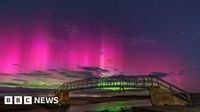For many, catching a glimpse of the northern lights is a rare, almost mystical experience—a bucket-list moment that leaves viewers with a sense of awe and wonder. This week, that magic has been on full display across vast stretches of North America and the United Kingdom, as a powerful geomagnetic storm sent waves of color rippling across the night sky, delighting stargazers from Alaska to the southern coast of England.
According to the Space Weather Prediction Center, the spectacle reached its peak on the night of September 2, 2025, when a strong geomagnetic storm—rated at a planetary K index (Kp) of 5—created conditions ripe for aurora borealis sightings far beyond their usual haunts near the poles. This level of activity, which sits in the “strong” range on the Kp scale (which runs from 0 to 9), meant that not only were northern regions like Canada and Alaska bathed in the aurora’s glow, but even states in the northern U.S.—Washington, Idaho, Montana, North Dakota, Minnesota, Wisconsin, and Michigan—had a shot at witnessing the phenomenon.
The northern lights, also known as aurora borealis, are a natural light show created when charged particles from the sun collide with gases in Earth's atmosphere. As NASA explains, this cosmic dance results in shimmering curtains of color—most commonly green, but also pink, purple, and even scarlet—that ripple and swirl across the sky. The science may be straightforward, but the effect is nothing short of enchanting.
In the United Kingdom, the excitement was palpable. The BBC reported that the aurora had been visible across Scotland and, in a rare treat, as far south as Dorset. For many in southern England, witnessing the northern lights with the naked eye, without the aid of cameras or special equipment, is almost unheard of. The aurora appeared as bright, swirling curtains of green, pink, and scarlet, casting an otherworldly glow over familiar landscapes.
Photographers and casual observers alike flocked to dark, open spaces in hopes of catching the show. In Hopeman, overlooking the Moray Firth, Carol More and her husband found themselves "mesmerised" by the view. As she told BBC News, it was "the best they had ever seen without looking through a camera." John Roach, snapping photos from Aberdeen, captured the eerie silhouette of Slains Castle, bathed in a green glow. "Whether an inspiration for the setting of Dracula or not... [it] looked pretty eerie in the midnight hour with the green glow of the aurora behind it," he remarked.
Other stunning images poured in from across the UK: Sheisa Fallon photographed the aurora from Bigton in Shetland and St Ninian's Isle, while BBC Weather Watchers like Sharon and Biba caught the lights over Glenrothes and Bora, respectively. On the west coast, the village of Clachtoll in the Highlands was treated to an early-morning display, and David managed a symmetrical shot of the sky reflected in the water at Bonar Bridge. The BBC encouraged viewers to share their own photos, noting that the recent displays had captivated the nation.
Back across the Atlantic, North Americans were urged to seize the opportunity. The Space Weather Prediction Center advised hopeful skywatchers to seek out dark places, far from the glare of city lights. As reported by Mashable and Lifehacker (both owned by Ziff Davis), even if the aurora wasn’t immediately visible to the naked eye, snapping a quick photo with a smartphone could reveal colors and patterns invisible to human vision. "If you're unsure whether you're seeing the northern lights, try taking a picture of the sky with your phone, which can capture a wider wavelength of light than the human eye," Lifehacker suggested.
But as seasoned aurora chasers know, there’s always an element of luck involved. Weather conditions play a crucial role—cloud cover can quickly dampen the show, no matter how strong the geomagnetic storm. In Scotland, the BBC noted that the best chances for viewing on September 3 were in the north, though the forecast wasn’t entirely favorable. Still, the thrill of possibility was enough to send many out into the night, scanning the horizons for signs of color.
What causes these dazzling displays? The process begins with the sun, which occasionally releases bursts of charged particles—known as solar wind—toward Earth. When these particles reach our planet, they interact with gases in the upper atmosphere, particularly oxygen and nitrogen. The result: electrons are excited to higher energy states and, as they return to normal, they release photons—the tiny packets of light that create the aurora’s signature glow. Oxygen tends to produce green and red hues, while nitrogen can add blue or purple tones to the mix.
The scale of this week’s auroral activity was notable not just for its intensity but for its reach. In the United States, sightings in states like Michigan and Wisconsin are uncommon, and in the UK, the phenomenon is typically reserved for Scotland and the far north. Yet, as the BBC documented, people from all walks of life—amateur photographers, weather watchers, and families—were able to witness the northern lights without the need for telescopes or special gear.
For those who missed out, experts say there’s always hope. The sun’s activity follows an 11-year cycle, with periods of increased solar storms and heightened auroral displays. As we approach the next solar maximum, opportunities for seeing the northern lights in unexpected places may become more frequent. In the meantime, the advice remains the same: keep an eye on space weather forecasts, find a dark spot, and don’t be afraid to try your luck with a camera.
Whether you’re a seasoned skywatcher or simply stumbled upon the spectacle by chance, the aurora’s fleeting beauty serves as a reminder of our planet’s connection to the wider cosmos—and the small, serendipitous gifts nature sometimes offers on an ordinary night.
